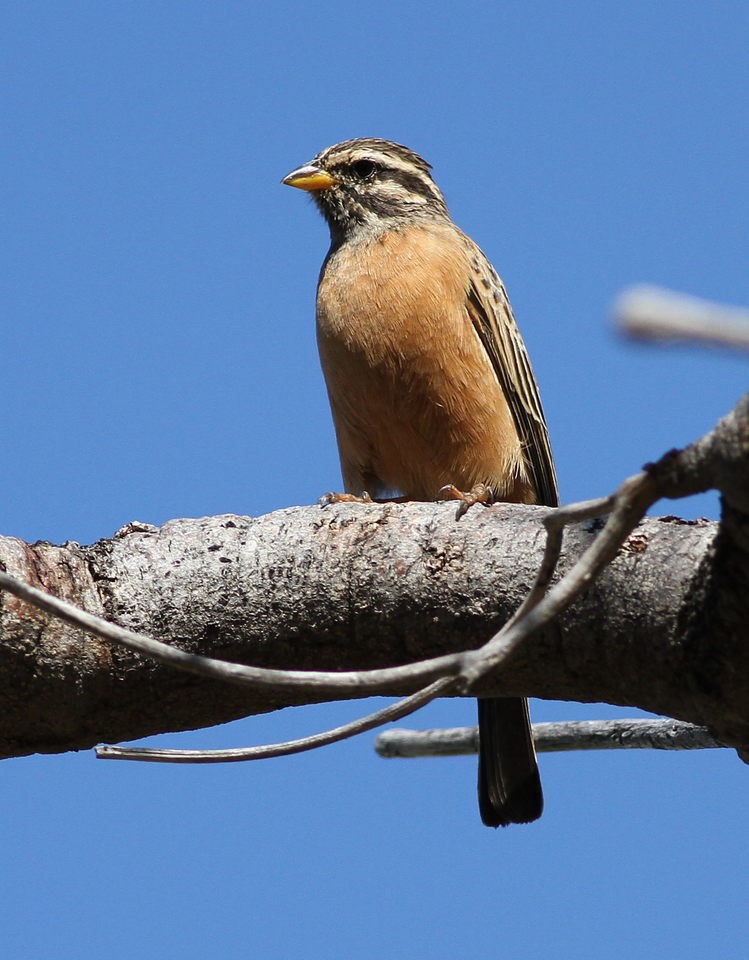Cinnamon-breasted Bunting
A species of Old World Buntings Scientific name : Emberiza tahapisi Genus : Old World Buntings
Cinnamon-breasted Bunting, A species of Old World Buntings
Botanical name: Emberiza tahapisi
Genus: Old World Buntings
Content
Description General Info
Description
They weigh between 11.6 and 21 grams with a length of 13-15 centimeters. Although plumage differs between juveniles, males, and females, cinnamon-breasted buntings can be identified by their striped head and cinnamon brown underparts. Males have black and white stripes whereas the female stripes are less dark and browner in color. The throat patch is uniformly black on males but smaller, grayish, and densely blotched on females. Juveniles are similar to females but with buffier head stripes and a paler, browner throat. After the breeding season, juveniles moult partially and adults moult completely so all primaries and secondaries are the same age. Cinnamon-breasted bunting songs are composed of short, high-pitched, rapid trills. Males are known to have eight distinct songs with 40 discrete syllables. Song similarity decreases with distance between local populations but all end with a characteristic final whistle syllable. Individuals perform songs from elevated positions such as from trees, bushes, or rocks. 
Size
15 cm
Nest Placement
Ground
Feeding Habits
Cinnamon-breasted Bunting primarily consumes grass seeds, alongside green leaves, nectar, and diverse insects such as termites and grasshoppers. It forages on the ground, utilizes recently burnt areas, drinks regularly, and exhibits unique preferences for salt licks and sun-bathing.
Habitat
Cinnamon-breasted Bunting typically reside in habitats with rocky hillsides, stony regions, and erosion gulleys across diverse ecosystems from arid scrublands to mesic woodlands, inclusive of Juniperus forests where open ground is available. These birds favor environments that may be described as degraded, such as old fields, paths, and roadside verges. Adequate bare soil and proximity to water sources, particularly in arid zones, are characteristic of their preferred habitats. Altitudinally, cinnamon-breasted Bunting are found up to 3000 meters in certain regions, though they typically occur at lower elevations.
Dite type
Granivorous
General Info
Feeding Habits
Bird food type
Behavior
Breeding time varies depending on the rainy season of the region. In arid regions with light rainfall, the breeding season will occur throughout the rainy season but in regions with heavier rainfall, the breeding season occurs at the end of the rainy season. They are monogamous but solitary nesters. The nest is built from twigs and grass and typically placed on the ground in a shaded area. Incubation and care for young is performed by both males and females. Incubation lasts 12–14 days and offspring fledge 14–16 days post-hatch but continue to feed in parental territory for three weeks. The clutch size is 2-4 and the eggs are greenish- or bluish-white with dark brown or reddish-brown speckles. Cinnamon-breasted buntings are ground gleaners that primarily eat seeds but have also been known to eat insects, especially in captivity. They will also sometimes jump to pull seeds. Chicks are fed seeds and insects by parents. They are commonly spotted alone or in pairs but also flock in groups of 3–4, and even 6-8 but less frequently so. However, migrating birds can be found in flocks of 40. Tail flicks are a common behavior that defines Emberiza and is used while hopping on the ground to make them more conspicuous to mates and other birds. Courtship behavior includes males chasing the female through the air, males bringing nest materials to nest and making “nest shaping movements”, and females quivering their wings while making a special repeating eep sound. Aggressive behavior includes a head forward position with bill snapping or gaping, with bill snapping occurring more frequently when fear is stronger than aggression. When fighting, special chaa, eee, and chu chatter sounds are made. Fear responses include freezing and observing when the perceived threat level is low, fleeing, and making alarm calls. Higher intensity behavior includes mobbing. 
Distribution Area
Having a very widespread distribution, cinnamon-breasted buntings are found across most of mainland sub-Saharan Africa but avoiding deserts, equatorial forest, and the high altitudes of mountains. They can be found in rocky, lightly wooded hillsides with sparse vegetation and bare soil but can sometimes be found in woodlands. There is some degree of partial migration with certain populations moving north during the rainy season and south during the dry season as well as moving to lower elevations during winter. 
Species Status
Not globally threatened.
Scientific Classification
Phylum
Chordates Class
Birds Order
Perching birds Family
New world sparrows Genus
Old World Buntings Species
Cinnamon-breasted Bunting 